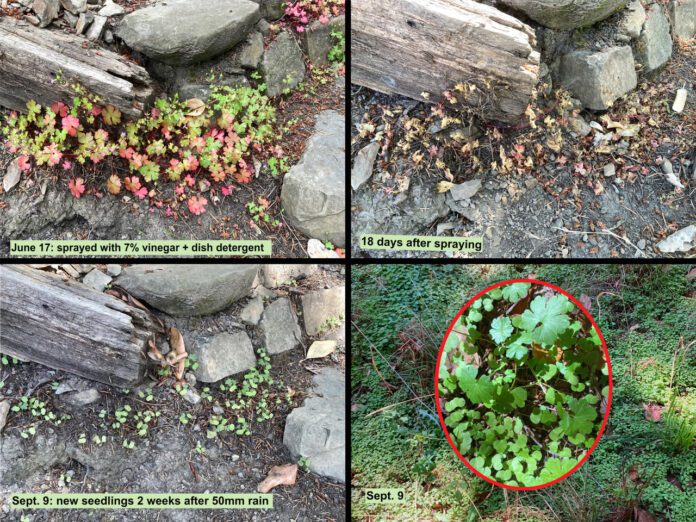For islanders who were alerted to the presence of shiny geranium on their properties earlier this year, efforts to nip its spread in the bud can start now.
Cathy Young of Transition Salt Spring’s Native Plant Stewardship Group said germination of the Geranium lucidum invasive plant is already well underway due to the heavy rainfall that occurred in late August.
A check of one of the patches on my property confirmed that was the case, and hand pulling of the tiny plants has begun. Somehow they don’t seem as pernicious when they are small, but it’s alarming to see how many seeds have germinated and would become full-sized seed-bearing plants if not removed.
“It is difficult to distinguish from dovesfoot cranesbill (Geranium molle) when small, but dovesfoot is also a non-native and somewhat invasive,” said Young, indicating that it’s probably okay if some dovesfoot are sacrificed while dealing with the shiny geranium.
“The characteristic smooth stems of shiny geranium won’t become red until plants have had some sun,” said Young, but I noticed that the bottom side of the smaller leaves have a red or pink hue and can be distinguished from dovesfoot that way.
The problem with shiny geranium is that it creates mats, or monocultures, that out-compete native plant communities, said Young. It is tolerant of all but the extremes of sun, shade, precipitation and soil types, though it prefers open forest floors, and has a long germination season — from now until late spring. Up to five generations of plants can exist on a single site in one year. Young said its seeds can be thrown up to 20 feet and the seeds survive at least two years in the ground.
Young recommends creating a solution of water with seven to 10 per cent vinegar, and adding a bit of dish detergent to help it stick, and applying to affected areas on dry and/or sunny days.
“It will kill the delicate leaves of annuals by rupturing the cells,” she said.
(She cautions that any vinegar solution of more than 11 per cent is capable of burning skin, damaging eyes and corroding metal.)
Flame weeding and hand-pulling also work, she said, and should be repeated when shiny geranium plants re-appear — perhaps monthly. Areas should be monitored closely and treatments or hand-pulling repeated the following year.
The B.C. government’s shiny geranium invasive species alert fact sheet has detailed information about the plant and identification tips.


